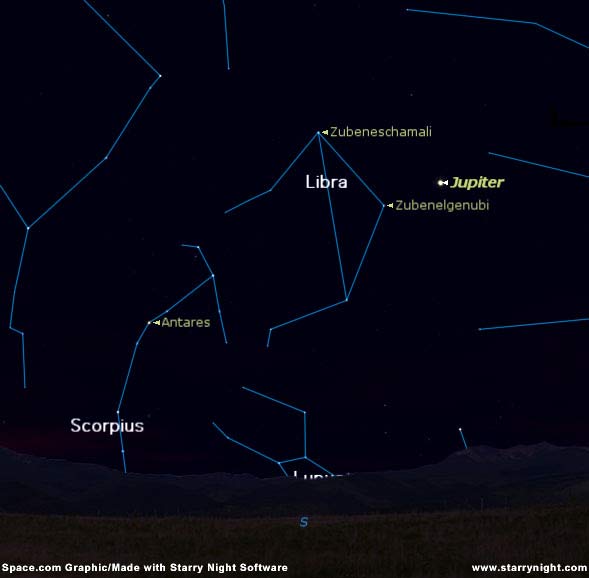
In our discussion a couple of weeks ago about the "Jupiter Triangle" that currently adorns our evening sky, I had failed to mention that Jupiter is currently located within the constellation of Libra, the Scales, one of the twelve constellations that form a belt around the sky, called the Zodiac.
It is toward the Zodiac we must look in order to find the Sun, the Moon and the Planets. And of all of the zodiacal constellations, Libra is the only star pattern that does not represent a person or an animal.
Known as the Scales or the Balance, Libra is marked by an oblong figure of stars and owes its importance only to its position in the zodiac. It supposedly consists of a beam with two pans hanging from it, for weighing things. The load in the right-hand pan must be heavier, for the balance is tilted down on that side. Libra was once associated with the constellation Virgo, as the scales of the goddess of Justice which that figure was supposed to represent.
Many years ago, one of the long-time lecturers at New York's Hayden Planetarium reprimanded me after I had given a sky show and pointed out Libra to my audience:
"Listen," he said, "the correct pronunciation is "LYbra," not "Le-bra. Remember, you go to a LYbrary, not a Lee-brary!"
I initially did not believe him, especially since I knew that the word library had its origins from the Latin word "libraria" (meaning book), while Libra was Latin for "balance;" hence two totally different things. But when I returned home and did some checking, I found that the World Book Encyclopedia (Field Enterprises Educational Corporation) indeed suggested the pronunciation LY-bruh, while The American Heritage Dictionary of the English Language (Houghton Mifflin Company) deems both LY and Lee as acceptable.
Now, whenever I look at Libra, I always think of my former Hayden colleague and in deference to him, stress the LY.
Get the Space.com Newsletter
Breaking space news, the latest updates on rocket launches, skywatching events and more!
Just to the east (left) of Libra these June evenings, the most beautiful zodiacal constellation can be found emerging into view low in the southeast sky: Scorpius, the Scorpion. Scorpions have two large claws in front, but this one seems to have had his claws clipped. In fact, the claws were indeed cut off to form Libra. A few thousand years ago, the Romans decided that there should be 12 constellations in the zodiac, instead of 11, so they made the two claws of Scorpius into the arms of Libra.
Libra was also known as "the Claws" of Scorpius the Scorpion to the poet Aratus and others of classical times. In fact, two of Libra's stars still bear the Arabic names, Zubeneschamali and Zubenelgenubi, meaning respectively, "Northern Claw" and "Southern Claw." Zubeneschamali also has a very faint greenish tinge: the only green naked-eye star.
Interestingly, Jupiter has been engaged in an unusual triple conjunction with Zubenelgenubi this year. It passed to the north of this star in January, passed it again in April (as Jupiter was moving west against the background stars in retrograde motion) and will pass closely north of this star for a third and final time on September 11.
The whole figure of the Scorpion is truly a magnificent sight-sort of a "celestial fish-hook"-and is best appreciated now a dark sky without any interference from bright moonlight. It really looks like a huge scorpion, with its long stinging tail curled over its back. It should be pointed out here that the currently accepted name of this constellation is Scorpius, not Scorpio.
Principally astrologers (and some older astronomy books) use the latter for labeling the zodiacal sign of that name.
One star clearly outshines the others, with a fiery tinge seemingly emphasizing the scorpion's sinister appearance. That's Antares, the so-called "rival of Mars," Ares being Greek for Mars. Antares is a supergiant, 700 times the Sun's diameter, over 9,000 times as luminous and located 604 light years away. The stars Shaula and Lesath are a close pair of stars in the Scorpion's stinger. Astronomy popularizer Hans A. Rey (1898-1977) christened these stars the "Cat's Eyes," noting, "You will find the name quite fitting."
Basic Sky Guides
- Full Moon Fever
- Astrophotography 101
- Sky Calendar & Moon Phases
- 10 Steps to Rewarding Stargazing
- Understanding the Ecliptic and the Zodiac
- False Dawn: All about the Zodiacal Light
- Reading Weather in the Sun, Moon and Stars
- How and Why the Night Sky Changes with the Seasons
- Night Sky Main Page: More Skywatching News & Features
Joe Rao serves as an instructor and guest lecturer at New York's Hayden Planetarium. He writes about astronomy for The New York Times and other publications, and he is also an on-camera meteorologist for News 12 Westchester, New York.
| DEFINITIONS |
1 AU, or astronomical unit, is the distance from the Sun to Earth, or about 93 million miles. Magnitude is the standard by which astronomers measure the apparent brightness of objects that appear in the sky. The lower the number, the brighter the object. The brightest stars in the sky are categorized as zero or first magnitude. Negative magnitudes are reserved for the most brilliant objects: the brightest star is Sirius (-1.4); the full Moon is -12.7; the Sun is -26.7. The faintest stars visible under dark skies are around +6. Degrees measure apparent sizes of objects or distances in the sky, as seen from our vantage point. The Moon is one-half degree in width. The width of your fist held at arm's length is about 10 degrees. The distance from the horizon to the overhead point (called the zenith) is equal to 90 degrees. Declination is the angular distance measured in degrees, of a celestial body north or south of the celestial equator. If, for an example, a certain star is said to have a declination of +20 degrees, it is located 20 degrees north of the celestial equator. Declination is to a celestial globe as latitude is to a terrestrial globe. Arc seconds are sometimes used to define the measurement of a sky object's angular diameter. One degree is equal to 60 arc minutes. One arc minute is equal to 60 arc seconds. The Moon appears (on average), one half-degree across, or 30 arc minutes, or 1800 arc seconds. If the disk of Mars is 20 arc seconds across, we can also say that it is 1/90 the apparent width of the Moon (since 1800 divided by 20 equals 90). |
Join our Space Forums to keep talking space on the latest missions, night sky and more! And if you have a news tip, correction or comment, let us know at: community@space.com.

Joe Rao is Space.com's skywatching columnist, as well as a veteran meteorologist and eclipse chaser who also serves as an instructor and guest lecturer at New York's Hayden Planetarium. He writes about astronomy for Natural History magazine, Sky & Telescope and other publications. Joe is an 8-time Emmy-nominated meteorologist who served the Putnam Valley region of New York for over 21 years. You can find him on Twitter and YouTube tracking lunar and solar eclipses, meteor showers and more. To find out Joe's latest project, visit him on Twitter.
